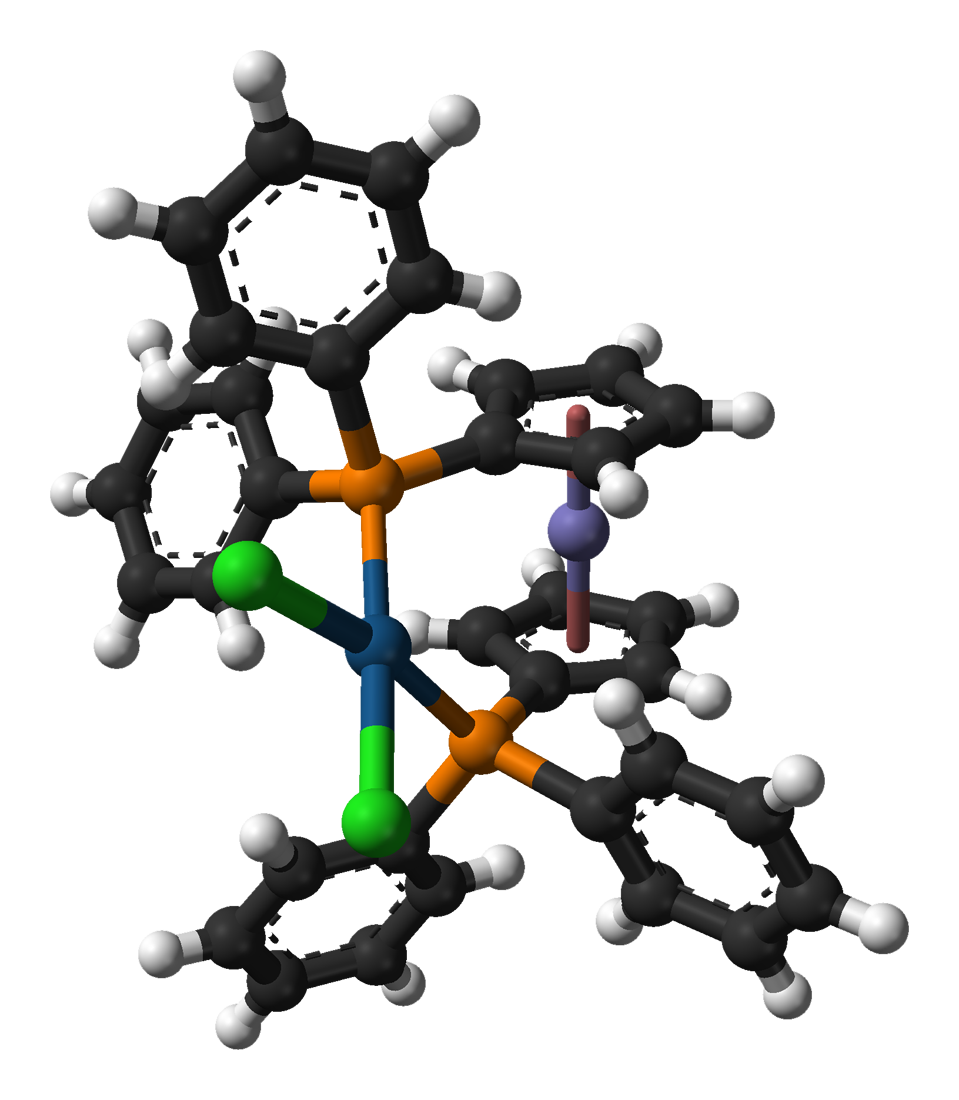|
1,1'-Dilithioferrocene
1,1'-Dilithioferrocene is the organoiron compound with the formula Fe(C5H4Li)2. It is exclusively generated and isolated as a solvate, using either ether or tertiary amine ligands bound to the lithium centers. Regardless of the solvate, dilithioferrocene is used commonly to prepare derivatives of ferrocene. Synthesis and reactions Treatment of ferrocene with butyl lithium gives 1,1'-dilithioferrocene, regardless of the stoichiometry (monolithioferrocene requires special conditions for its preparation). Typically the lithiation reaction is conducted in the presence of tetramethylethylenediamine (tmeda). The adduct [Fe(C5H4Li)2]3(tmeda)2 has been crystallized from such solutions. Recrystallization of this adduct from thf gives [Fe(C5H4Li)2]3(thf)6. 1,1'-Dilithioferrocene reacts with a variety of electrophiles to afford disubstituted derivatives of ferrocene. These electrophiles include octasulfur, S8 (to give 1,1'-Ferrocenetrisulfide, 1,1'-ferrocenetrisulfide), chlorophosphines ... [...More Info...] [...Related Items...] OR: [Wikipedia] [Google] [Baidu] |
Ferrocene
Ferrocene is an organometallic compound with the formula . The molecule is a complex consisting of two cyclopentadienyl rings bound to a central iron atom. It is an orange solid with a camphor-like odor, that sublimes above room temperature, and is soluble in most organic solvents. It is remarkable for its stability: it is unaffected by air, water, strong bases, and can be heated to 400 °C without decomposition. In oxidizing conditions it can reversibly react with strong acids to form the ferrocenium cation . The rapid growth of organometallic chemistry is often attributed to the excitement arising from the discovery of ferrocene and its many analogues, such as metallocenes. History Discovery Ferrocene was discovered by accident thrice. The first known synthesis may have been made in the late 1940s by unknown researchers at Union Carbide, who tried to pass hot cyclopentadiene vapor through an iron pipe. The vapor reacted with the pipe wall, creating a "yellow slu ... [...More Info...] [...Related Items...] OR: [Wikipedia] [Google] [Baidu] |
Organoiron Compound
Organoiron chemistry is the chemistry of iron compounds containing a carbon-to-iron chemical bond. Organoiron compounds are relevant in organic synthesis as reagents such as iron pentacarbonyl, diiron nonacarbonyl and disodium tetracarbonylferrate. While iron adopts oxidation states from Fe(−II) through to Fe(VII), Fe(IV) is the highest established oxidation state for organoiron species. Although iron is generally less active in many catalytic applications, it is less expensive and " greener" than other metals. Organoiron compounds feature a wide range of ligands that support the Fe-C bond; as with other organometals, these supporting ligands prominently include phosphines, carbon monoxide, and cyclopentadienyl, but hard ligands such as amines are employed as well. Iron(0) and more reduced states Carbonyl complexes Important iron carbonyls are the three neutral binary carbonyls, iron pentacarbonyl, diiron nonacarbonyl, and triiron dodecacarbonyl. One or more carbonyl ligands ... [...More Info...] [...Related Items...] OR: [Wikipedia] [Google] [Baidu] |
Butyl Lithium
Butyllithium may refer to one of 5 isomeric organolithium reagents of which 3 are commonly used in chemical synthesis: * ''n''-Butyllithium, abbreviated BuLi or nBuLi * ''sec''-Butyllithium, abbreviated ''sec''-BuLi or sBuLi, has 2 stereoisomers, but is commonly used as racemate *isobutyllithium * ''tert''-Butyllithium, abbreviated ''tert''-BuLi or tBuLi {{Chemistry index ... [...More Info...] [...Related Items...] OR: [Wikipedia] [Google] [Baidu] |
Tetramethylethylenediamine
Tetramethylethylenediamine (TMEDA or TEMED) is a chemical compound with the formula (CH3)2NCH2CH2N(CH3)2. This species is derived from ethylenediamine by replacement of the four amine hydrogens with four methyl groups. It is a colorless liquid, although old samples often appear yellow. Its odor is similar to that of rotting fish. As a reagent in synthesis TMEDA is widely employed as a ligand for metal ions. It forms stable complexes with many metal halides, e.g. zinc chloride and copper(I) iodide, giving complexes that are soluble in organic solvents. In such complexes, TMEDA serves as a bidentate ligand. TMEDA has an affinity for lithium ions. When mixed with ''n''-butyllithium, TMEDA's nitrogen atoms coordinate to the lithium, forming a cluster of higher reactivity than the tetramer or hexamer that ''n''-butyllithium normally adopts. BuLi/TMEDA is able to metallate or even doubly metallate many substrates including benzene, furan, thiophene, ''N''-alkylpyrroles, and ... [...More Info...] [...Related Items...] OR: [Wikipedia] [Google] [Baidu] |
Octasulfur
Octasulfur is an inorganic substance with the chemical formula . It is an odourless and tasteless yellow solid, and is a major industrial chemical. It is the most common allotrope of sulfur and occurs widely in nature.Steudel, R., "Homocyclic Sulfur Molecules", Topics Curr. Chem. 1982, 102, 149. Nomenclature The name octasulfur is the most commonly used for this chemical. It is systematically named ''cyclo''-octasulfur (which is the preferred IUPAC name) and cyclooctasulfane. It is also the final member of the thiocane heterocylic series, where every carbon atom is substituted with a sulfur atom, thus this sulfur allotrope is systematically named octathiocane as well. Structure The chemical consists of rings of 8 sulfur atoms. It adopts a crown conformation with D4d point group symmetry. The S–S bond lengths are equal, at about 2.05 Å. Octasulfur crystallizes in three distinct polymorphs: rhombohedral, and two monoclinic forms, of which only two are stable at standard co ... [...More Info...] [...Related Items...] OR: [Wikipedia] [Google] [Baidu] |
1,1'-Ferrocenetrisulfide
1,1'-Ferrocenetrisulfide is the organoiron compound with the formula . A yellow solid, it is the simplest polysulfide derivative of ferrocene. It can be synthesized by treatment of dilithioferrocene with elemental sulfur. Using proton NMR spectroscopy Proton nuclear magnetic resonance (proton NMR, hydrogen-1 NMR, or 1H NMR) is the application of nuclear magnetic resonance in NMR spectroscopy with respect to hydrogen-1 nuclei within the molecules of a substance, in order to determine the struct ..., the relatively slow conformational flexing of the trisulfide ring can be established. : References Ferrocenes Cyclopentadienyl complexes Polysulfides {{organic-compound-stub ... [...More Info...] [...Related Items...] OR: [Wikipedia] [Google] [Baidu] |
Chlorosilane
Chlorosilanes are a group of reactive, chlorine-containing chemical compounds, related to silane and used in many chemical processes. Each such chemical has at least one silicon-chlorine bond. Trichlorosilane is produced on the largest scale. The parent chlorosilane is silicon tetrachloride ().. Synthesis Hydrochlorosilanes They are prepared by the Müller-Rochow process, which involves treating silicon with hydrogen chloride at elevated temperatures in the presence of a copper catalyst. The idealized equation is :2 Si + 6 HCl → 2 HSiCl3 + 2 H2, Trichlorosilane (HSiCl3) is the main product; dichlorosilane (H2SiCl2) and silicon tetrachloride (SiCl4) are obtained as byproducts. The process was independently discovered by Eugene G. Rochow and Richard Müller in 1940. Methylchlorosilanes Methyltrichlorosilane (CH3SiCl3), dimethyldichlorosilane ((CH3)2SiCl2), and trimethylsilyl chloride ((CH3)3SiCl) are produced by the direct process. They are key reagents in organosilicon chemis ... [...More Info...] [...Related Items...] OR: [Wikipedia] [Google] [Baidu] |
Diphosphine Ligand
Diphosphines, sometimes called bisphosphanes, are organophosphorus compounds most commonly used as bidentate phosphine ligands in inorganic and organometallic chemistry. They are identified by the presence of two phosphino groups linked by a backbone, and are usually chelating. A wide variety of diphosphines have been synthesized with different linkers and R-groups. Alteration of the linker and R-groups alters the electronic and steric properties of the ligands which can result in different coordination geometries and catalytic behavior in homogeneous catalysts. Synthesis 222px, Chlorodiisopropylphosphine is a popular building block for the preparation of diphosphines. From phosphide building blocks Many widely used diphosphine ligands have the general formula Ar2P(CH2)nPAr2. These compounds can be prepared from the reaction of X(CH2)nX (X=halogen) and MPPh2 (M = alkali metal): :Cl(CH2)nCl + 2 NaPPh2 → Ph2P(CH2)nPPh2 + 2 NaCl Diphosphine ligands can also be prepar ... [...More Info...] [...Related Items...] OR: [Wikipedia] [Google] [Baidu] |
1,1'-Bis(diphenylphosphino)ferrocene
1,1-Bis(diphenylphosphino)ferrocene, commonly abbreviated dppf, is an organophosphorus compound commonly used as a ligand in homogeneous catalysis. It contains a ferrocene moiety in its backbone, and is related to other bridged diphosphines such as 1,2-bis(diphenylphosphino)ethane (dppe). Preparation This compound is commercially available. It may be prepared by treating dilithioferrocene with chlorodiphenylphosphine: :Fe(CHLi) + 2 ClPPh → Fe(CHPPh) + 2 LiCl The dilithiation of ferrocene is easily achieved with ''n''-butyllithium in the presence of TMEDA. Many related ligands can be made in this way. The Fe center is typically not involved in the behavior of the ligand. Reactions Dppf readily forms metal complexes. The palladium derivative, (dppf)PdCl, which is popular for palladium-catalyzed coupling reactions, is prepared by treating dppf with the acetonitrile or benzonitrile adducts of palladium dichloride: Substitution of the phenyl substituents in dppf leads to deriv ... [...More Info...] [...Related Items...] OR: [Wikipedia] [Google] [Baidu] |
Chlorodiphenylphosphine
Chlorodiphenylphosphine is an organophosphorus compound with the formula (C6H5)2PCl, abbreviated Ph2PCl. It is a colourless oily liquid with a pungent odor that is often described as being garlic-like and detectable even in the ppb range. It is useful reagent for introducing the Ph2P group into molecules, which includes many ligands.Quin, L. D. ''A Guide to Organophosphorus Chemistry''; Wiley IEEE: New York, 2000; pp 44-69. Like other halophosphines, Ph2PCl is reactive with many nucleophiles such as water and easily oxidized even by air. Synthesis and reactions Chlorodiphenylphosphine is produced on a commercial scale from benzene and phosphorus trichloride (PCl3). Benzene reacts with phosphorus trichloride at extreme temperatures around 600 °C to give dichlorophenylphosphine (PhPCl2) and HCl. Redistribution of PhPCl2 in the gas phase at high temperatures results in chlorodiphenylphosphine. :2PhPCl2 → Ph2PCl + PCl3 Alternatively such compounds are prepared by redistrib ... [...More Info...] [...Related Items...] OR: [Wikipedia] [Google] [Baidu] |



